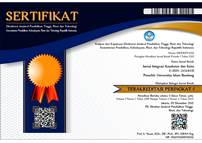Durasi Screen Time Smartphone dengan Keluhan Mata Kering pada Mahasiswa
Abstract
Abstrak
Dampak screen time smartphone yang tinggi dapat memengaruhi kesehatan mata, salah satunya keluhan mata kering. Penelitian ini bertujuan menganalisis hubungan antara durasi screen time smartphone dan keluhan mata kering pada mahasiswa Fakultas Kedokteran Universitas Islam Bandung. Penelitian ini merupakan studi analitik cross-sectional. Sampel dipilih menggunakan purposive sampling dengan jumlah 145 mahasiswa Fakultas Kedokteran Universitas Islam Bandung periode Juni–November 2022 Alat ukur yang digunakan, yaitu kuesioner Ocular Surface Disease Index (OSDI). Uji statistik menggunakan chi-square test. Hasil penelitian menunjukkan bahwa durasi screen time smartphone mahasiswa Fakultas Kedokteran Universitas Islam Bandung dengan gejala mata kering terbagi dalam dua kelompok, yaitu kelompok durasi <6 jam/hari sebanyak 45 orang (91,8%) dan kelompok durasi >7 jam/hari sebanyak 74 orang (77,1%). Terdapat hubungan yang signifikan secara statistik antara durasi screen time smartphone dan keluhan mata kering pada mahasiswa Fakultas Kedokteran Universitas Islam Bandung (nilai p=0,04). Pemeriksaan keluhan mata kering menggunakan kuesioner Ocular Surface Disease Index (OSDI) bersifat subjektif, perlu pemeriksaan objektif untuk mendapatkan proporsi mata kering yang sebenarnya dalam dua kelompok screen time.
Duration of Smartphone Screen Time with Dry Eye Complaints in University Students
Abstract
High smartphone screen time can impact eye health, including dry eye symptoms. This study aims to investigate the relationship between smartphone screen time and dry eye symptoms in students at the Faculty of Medicine Bandung Islamic University. This study uses an observational analytic research method with a cross-sectional type. Purposive sampling was used for sample selection, and the research subjects included 145 students from the Faculty of Medicine Bandung Islamic University from June–November 2022. A statistical test used was the chi-square test. The results of this study showed that the duration of smartphone screen time in students of the Faculty of Medicine Bandung Islamic University with dry eye symptoms is divided into two groups, namely the <6 hours/day duration group of 45 people (91.8%) and the >7 hours/day duration group of 74 people (77.1%). There is a statistically significant correlation between the duration of smartphone screen time and the incidence of dry eye symptoms in students of the Faculty of Medicine Bandung Islamic University (value of p=0.04). Examining complaints of dry eye symptoms with the subjective Ocular Surface Disease Index (OSDI) questionnaire requires an objective examination to determine the actual proportion of dry eye in the two screen time groups.
Keywords
Full Text:
PDF (Bahasa Indonesia)References
Wolff HN. Smartphone users in Indonesia 2017- 2026 [Internet]. 2021 [diunduh 23 Januari 2022]. Tersedia dari: https://www.statista. com/statistics/266729/smartphone-users-in- indonesia/.
Wolff HN. Smartphone market in Indonesia - Statistics and facts [Internet]. 2021 [diunduh 24 Januari 2022];44:1–6. Tersedia dari: https:/www.statista.com/topics/5020/smartphones-in- indonesia/.
Yustika G, Rimayanti U, Izzati MY, Ansar AMF. The description of screen time and dry eye symptoms in students during the covid-19 pandemic. Dalam: Akbar RR, Anissa M, penyunting. Proceeding ICME 2021 Virtual Conference: excellence in health profession education; through globalization. Yogyakarta: UII Press; 2021. hlm. 185–93.
Mufti M, Sayeed SI, Jaan I, Nazir S. Does digital screen exposure cause dry eye?. Indian J Clin Anat Physiol. 2019 Jan 16;6(1):68–72.
Stiglic N, Viner RM. Effects of screentime on the health and well-being of children and adolescents: a systematic review of reviews. BMJ Open. 2019;9(1):1–15.
Golebiowski B, Long J, Harrison K, Lee A, Chidi- Egboka N, Asper L. Smartphone use and effects on tear film, blinking and binocular vision. Curr Eye Res [Internet]. 2020 [diunduh 24 Januari 2022];45(4):428–34. Tersedia dari: https://pubmed.ncbi.nlm.nih.gov/31573824/.
Casey A, Marina S. Klasifikasi, diagnosis, dan pengobatan saat ini untuk penyakit mata kering. Intisari Sains Medis. 2021;12(2):640–4.
EM M. The pathophysiology, diagnosis, and treatment of dry eye disease. Dtsch Arztebl Int [Internet]. 2015 [diunduh 25 Januari 2022];112:71–81. Tersedia dari: https://www. ncbi.nlm.nih.gov/pmc/articles/PMC4335585/.
Golden MI, Meyer JJ, Patel BC. Dry eye syndrome [Internet]. 2017 [diunduh 25 Januari 2022]. Tersedia dari: https://www.ncbi.nlm.nih.gov/ books/NBK470411/.
Stapleton F, Alves M, Bunya VY, Jalbert I, Lekhanont K, Malet F, dkk. TFOS DEWS II epidemiology report. Ocul Surf. 2017;15(3):334– 65.
Jansen JA, Kuswidyati C, Chriestya F. Association between screen time and dry eye symptoms. J Kedokt Kesehat Indones. 2021;12(2):144–50.
Akib MN, Pirade SR, Syawal SR, Fauzan MM, Eka H, Seweng A. Association between prolonged use of smartphone and the incidence of dry eye among junior high school students. Clin Epidemiol Glob Heal. 2021;11:100761.
Apriyanti S, Sawitri E, Fatmawati NK. Penggunaan smartphone berpengaruh terhadap gejala computer vision syndrome. J Sains Kesehat. 2021;3(5):673–8.
Al-Mohtaseb Z, Schachter S, Lee BS, Garlich J, Trattler W. The relationship between dry eye disease and digital screen use. Clin Ophthalmol [Internet]. 2021 [diunduh 18 Desember 2022];15:3811–20. Tersedia dari: https://www.ncbi.nlm.nih.gov/pmc/articles/PMC8439964/#cit0030.
Puspa AK, Loebis R, Nuswantoro D. Pengaruh penggunaan gadget terhadap penurunan kualitas penglihatan siswa sekolah dasar. Glob Med Heal Commun. 2018;6(1):28–33.
Widyadana ND. Pengaruh intensitas penggunaan gadget di era pandemi terhadap eye fatigue. Lorong Media Pengkaj Sos Budaya. 2022;11(1):58–71.
KOMINFO. Survey Penggunaan TIK 2017. Jakarta: KOMINFO; 2017.
Hasanah MD, Maria I, Iskandar MM, Istarini A, Gading PW. Hubungan screen time dengan kejadian migrain pada mahasiswa kedokteran Universitas Jambi angkatan 2018. J Med. 2018;2:1– 12.
Rafique N, Alkaltham GKI, Almulhim LAA, Al-Asoom LI, AlSunni AA, AlSheikh M, dkk. Relationship between screen time and body mass index in young adults. Res Sq. 2022:1–12.
Muntz A, RK Turnbull P, D Kim A, Gokul A, Wong D, Tsay TS-W, dkk. Extended screen time and dry eye in youth. Contact Lens Anterior Eye [Internet]. 2022 [diunduh 18 Desember 2022];45(5):101541. Tersedia dari: https://www.sciencedirect.com/ science/article/abs/pii/S1367048421001764
Christina Rapp Prescott M. Increased screen time and dry eye: another complication of covid-19. Eye Contact Lens [Internet]. 2021;47(8):433. [diunduh 18 Desember 2022] Tersedia dari: https://www.ncbi.nlm.nih.gov/pmc/articles/PMC8294656/
Latupono S, Tualeka S, Taihuttu Y. Hubungan penggunaan media elektronik visual dengan kejadian sindroma mata kering di Fakultas Kedokteran Universitas Pattimura. Molucca Medica. 2021 April;14:22–35.
DOI: https://doi.org/10.29313/jiks.v5i2.11519
Refbacks
- There are currently no refbacks.
Jurnal Integrasi Kesehatan dan Sains is licensed under a Creative Commons Attribution-NonCommercial-ShareAlike 4.0 International License.







.png)
_(1).png)




















